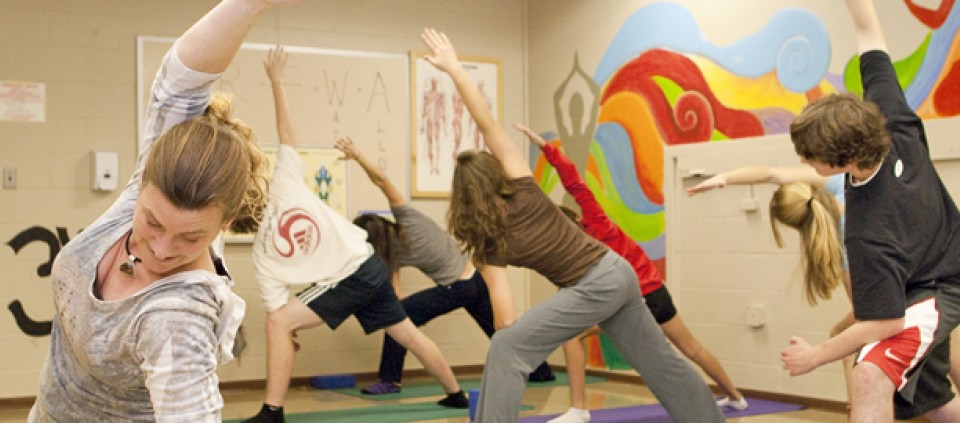The High School Brain on Yoga

Like most of us, I would not want to relive my teenage years—unless I could do so knowing what I know now. Even so, I’ve been drawn to working with teenagers in my adult life. As a high school biology teacher back in my twenties and in my current role as a yoga educator in high schools, I’ve been able to pursue my passion for providing teenagers with tools for coping—tools I wish I’d had at their age.
Working with our partners at Brigham and Women's Hospital, Kripalu researches how yoga affects teenagers, and we’ve found that it does indeed have beneficial effects on students’ resilience and ability to manage anger. I’m confident that I’m providing students with the wisdom and tools to help them navigate their teenage years in healthier, more skillful ways.
Parents, educators, and kids themselves often can’t quite figure out teenage behavior. It was long thought that hormones running amok caused teens’ mystifying behaviors and attitudes. However, new research in neurobiology has challenged that theory and places the onus squarely on the fact that the teenage brain is still very much under construction. It turns out that the brain is the last organ to fully mature—it develops well into our twenties.
During adolescence, the frontal lobes of the brain (the seat of language and reason) are still being formed, leaving teens to overly rely on their amygdala (the seat of emotions). As Sheryl Feinstein, author of the Secrets of the Teenage Brain, puts it, “Teens are navigating a cerebral hurricane without a compass.”
The brain’s malleability during adolescence marks a crucial stage in both cognitive and emotional development. Luckily, researchers are now able to paint a clearer picture of some of the factors that allow students to thrive throughout high school and into adulthood, such as self-awareness, managing distressing emotions, empathy, and navigating relationships smoothly. When students hone these skills, they are not only happier and healthier emotionally, but are also better able to focus on academics.
My work at Kripalu has been to develop a curriculum that combines the practice of yoga with mindfulness tools to help students thrive in yoga class and beyond. The curriculum that my fellow program leader, Janna Delgado, and I created combines breathing and centering practices, community-building exercises, experiential activities, yoga postures, relaxation techniques, and loving-kindness meditation to help students cultivate healthful ways to manage their emotions and stress levels. Our qualitative research, conducted in partnership with Sat Bir S. Khalsa, has shown that students in the yoga program experience improved well-being, especially in the areas of sleep, emotion and stress regulation, and reduced interest in substance use. In teaching to more than 500 students, I’ve seen examples of these effects time and again.
One student who started the program with such a severe anxiety disorder that she could barely participate in the yoga classes was confidently teaching a yoga posture to her peers by the end of the program. A few students who entered the program with severe ADHD symptoms were able, over time, to lie completely still and relaxed for a full five minutes. As one of my ninth-graders reported, “Yoga relaxed me, made me much calmer. I was less grouchy, less snappy toward people, and I don’t have as much of an attitude with my mom as I used to.” Another ninth-grader reported feeling, “a lot happier lately...I feel like a better person, making better choices, and staying out of trouble.”
I’ve deeply enjoyed hearing from my students about how they incorporate yoga into their lives, from using their breath to calm down during a stressful situation to stepping back and not sending the angry text message they’d written. Some students put their legs up the wall for several minutes before going to bed to help them fall asleep faster and to sleep more soundly. Others use Alternate-Nostril Breath to help them engage both hemispheres of their brain and relax before taking a test. It’s an exciting prospect to think of schools offering yoga to allow teens to more skillfully navigate their way through adolescence and help build themselves happier, healthier brains and more fulfilling, safer teenage years.
Find out about Kripalu Yoga in the Schools Teacher Training.
© Kripalu Center for Yoga & Health. All rights reserved. To request permission to reprint, please e-mail editor@kripalu.org.
Iona M. Smith, MEd, CYT 500, a yoga educator focused on bringing mindful resilience to those who need it most, is a Kripalu RISE™ facilitator and a Program Leader for Kripalu Yoga in the Schools.
Full Bio and Programs